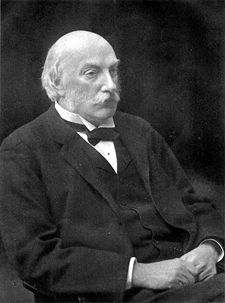John Strutt, 3rd Baron Rayleigh
<<ASIMOV'S BIOGRAPHICAL ENCYCLOPEDIA MENTIONS THAT RAYLEIGH GREW INTERESTED IN PSYCHIC RESEARCH. THIS ASPECT OF HIS LIFE SHOULD BE EXPLORED AND NOTED IN THIS ARTICLE.>>
|
Lord Rayleigh | |
|---|---|
 John William Strutt, 3rd Baron Rayleigh | |
| Born |
12 November 1842 |
| Died | 30 June 1919 Terling Place, Witham, Essex, UK |
| Residence | |
| Nationality | |
| Field | Physicist |
| Institutions | University of Cambridge |
| Alma mater | University of Cambridge |
| Academic advisor | Edward John Routh |
| Notable students | J. J. Thomson George Paget Thomson 20px Jagdish Chandra Bose |
| Known for | Discovery of argon Rayleigh waves Rayleigh scattering Rayleigh criterion |
| Notable prizes | |
John William Strutt, 3rd Baron Rayleigh (12 November 1842 – 30 June 1919) was an English physicist who (with William Ramsay) discovered the element argon, an achievement that earned him the Nobel Prize for Physics in 1904. He also discovered the phenomenon now called Rayleigh scattering and predicted the existence of the surface waves now known as Rayleigh waves.
Biography
Strutt was born in Langford Grove, Essex and in his early years suffered frailty and poor health.
He went to Harrow School and began studying mathematics at Trinity College, Cambridge, in 1861. In 1865, he obatined his BA (Senior Wrangler and 1st Smith's prize) and MA in 1868. He was subsequently elected to a Fellowship of Trinity. He held the post until his marriage to Evelyn Balfour, daughter of James Maitland Balfour in 1871. He had three sons with her.
In 1873 his father, John Strutt, 2nd Baron Rayleigh died, and he inherited the Barony of Rayleigh.
He was the second Cavendish Professor of Physics at the University of Cambridge, following James Clerk Maxwell in this position from 1879 to 1884.
Approximately 1900 Lord Rayleigh developed the Duplex (combination of two) Theory (Human sound localization using two binaural cues). Interaural time delay (ITD) and interaural level difference (ILD) (assuming a spherical head with no external pinnae). Humans perceive sound objects spatially, using the difference in the phase (time delay) of the sound and the difference in amplitude (level) between the two ears, in a similar way that stereoscopic sight provides depth perception. Also called two primary cues for azimuth (horzontal location) but possibly its two primary cues for a 3 dimensional bearing. For example when you hear a seagull call out you can determine roughly x y and z location of the sound. Although Pinnae reflections are considered a main cue for vertical localisation.
Lord Rayleigh was elected to Fellow of the Royal Society on June 12, 1873 and was elected president of the Royal Society between 1905 and 1908.
Lord Rayleigh died on June 30, 1919 in Witham, Essex.
Craters on Mars and the Moon are named in his honor as well as a type of surface wave known as a Rayleigh wave.
Prizes
- Royal Medal (1882)
- Matteucci Medal (1894)
- Copley Medal (1899)
- Nobel Prize for Physics (1904)
- Rumford Medal (1920)
See also
- Rayleigh criterion
- Rayleigh fading
- Rayleigh number
- Rayleigh quotient
- Rayleigh scattering
- Rayleigh (unit) (named after his son)
- Rayleigh waves
- Rayleigh-Jeans law
- Rayleigh distribution
- Rayleigh-Taylor instability
Notes
References and further reading
- Nobel website bio of Rayleigh
- About John William Strutt
- John J. O'Connor and Edmund F. Robertson. John Strutt, 3rd Baron Rayleigh at the MacTutor archive
- Plateau-Rayleigh Instability - a 3D lattice kinetic Monte Carlo simulation
| Honorary Titles | ||
|---|---|---|
| Preceded by: The Lord Carlingford |
Lord Lieutenant of Essex 1892–1901 |
Succeeded by: The Earl of Warwick |
| Preceded by: William Huggins |
President of the Royal Society 1905–1908 |
Succeeded by: Sir Archibald Geikie |
| Preceded by: The Duke of Devonshire |
Chancellor of the University of Cambridge 1908–1919 |
Succeeded by: Arthur Balfour |
| Peerage of the United Kingdom
| ||
| Preceded by: John Strutt |
Baron Rayleigh 1873–1919 |
Succeeded by: Robert Strutt |
| ||||||||||||||||||||
| Persondata | |
|---|---|
| NAME | Rayleigh, Lord |
| ALTERNATIVE NAMES | |
| SHORT DESCRIPTION | Physicist |
| DATE OF BIRTH | 12 November 1842 |
| PLACE OF BIRTH | Langford Grove, Maldon, Essex, UK |
| DATE OF DEATH | 30 June 1919 |
| PLACE OF DEATH | Terling Place, Witham, Essex, UK |
Credits
New World Encyclopedia writers and editors rewrote and completed the Wikipedia article in accordance with New World Encyclopedia standards. This article abides by terms of the Creative Commons CC-by-sa 3.0 License (CC-by-sa), which may be used and disseminated with proper attribution. Credit is due under the terms of this license that can reference both the New World Encyclopedia contributors and the selfless volunteer contributors of the Wikimedia Foundation. To cite this article click here for a list of acceptable citing formats.The history of earlier contributions by wikipedians is accessible to researchers here:
The history of this article since it was imported to New World Encyclopedia:
Note: Some restrictions may apply to use of individual images which are separately licensed.
